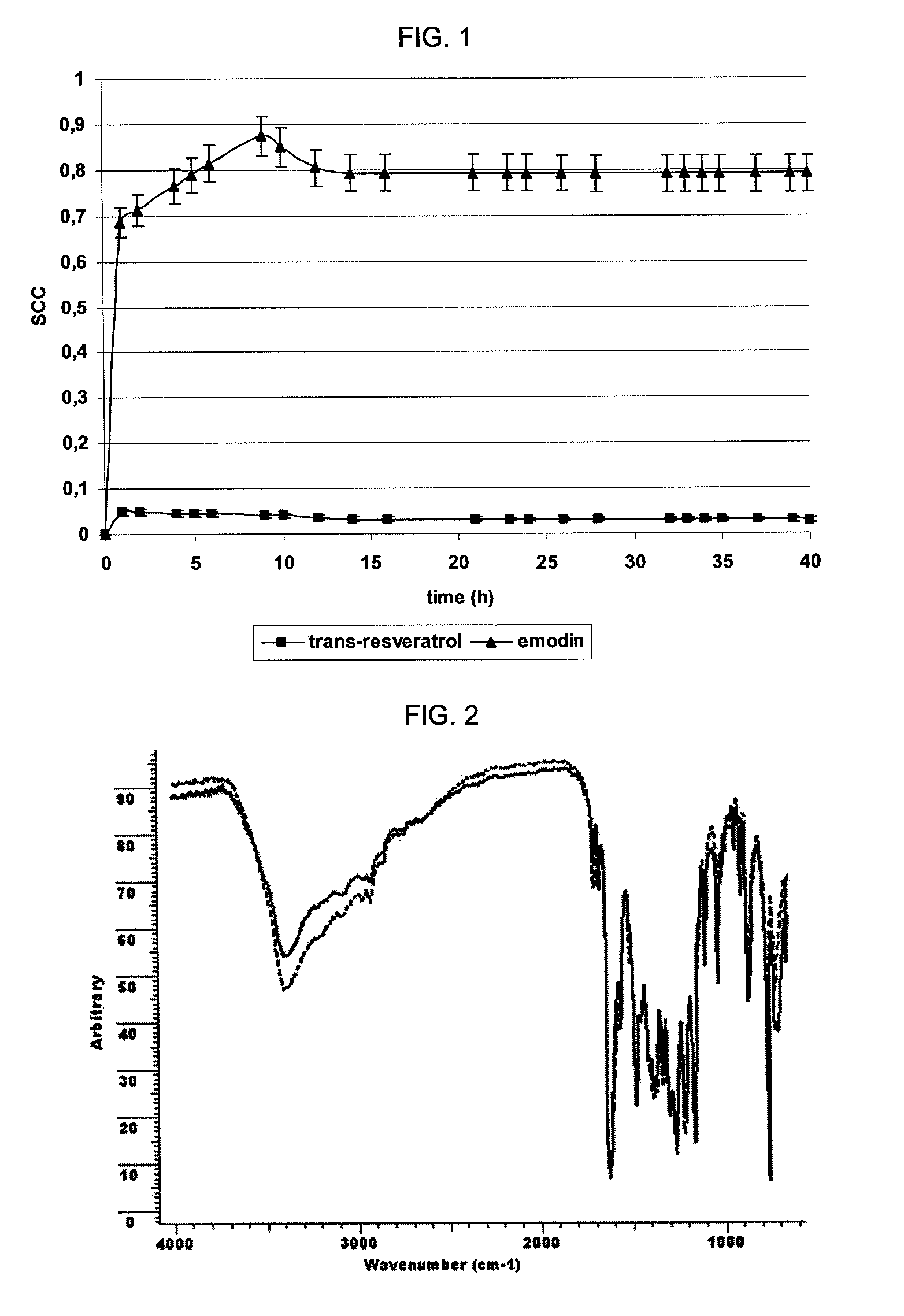Process of obtainment of trans-resveratrol and/or emodin and nutraceutical compositions containing them
a technology of emodin and transresveratrol, which is applied in the direction of biocide, plant growth regulator, plant ingredients, etc., can solve the problems of blood vessel obstruction, solvent recovery and solvent recovery difficulties, and achieve the effects of reducing obesity, high purity, and inhibiting activity
- Summary
- Abstract
- Description
- Claims
- Application Information
AI Technical Summary
Benefits of technology
Problems solved by technology
Method used
Image
Examples
example 1
Obtaining Trans-Resveratrol from an Imported Extract of Polygonum cuspidatum
[0038]The method for obtaining the present preferential compounds consists of solid-liquid extraction, Soxhlet type or similar, from the extract of Polygonum cuspidatum with different solvents. The first solvent used is toluene during a period of 2-40 hours for extracting mainly anthraquinone. Solvent is cooled at room temperature for obtaining emodin crystals (3-methyl-1,6,8-trihydroxyanthraquinone) with a yield of 4-6% and purity of 91-96%. The second solvent is hexane or petroleum ether for washing during a period of 1-2 hours in order to eliminate impurities. The third solvent is diethyl ether during a period of 2-24 hours. Solvent is evaporated to obtain trans-resveratrol (3,5,4′-trihydroxiestilbeno), with a yield of 5-7% and purity of 92-98%. For this preferred embodiment, the imported extract of Polygonum cuspitadum was acquired from Galena Química e Farmacêutica Ltda. Solvents were acquired from spe...
example 2
Obtaining Trans-Resveratrol from Roots of Rumex acetosa
[0048]Plant vegetal material was obtained at Pontifical Catholic University of Rio Grande do Sul. Rumex acetosa roots (5 g) were washed and extracted with a solution of ethanol / water (70:30) for 15 minutes under stirring. The obtained material was centrifuged at 1000 g for 10 minutes, filtered in a 0.45 μm pore diameter membrane, and then subjected to High-Performance Liquid Chromatography. The analyses were performed in a Perkin Elmer HPLC chromatograph equipped with UV-VIS detector and a C18 column, 5 μm 250×4.6 mm. Rumex acetosa extract was diluted 100 times with eluent and 20 μL were injected and detected in 306 nm. HPLC chromatography was carried out in isocratic elution (flow of 1.0 mL / min−1), with an aqueous solution of 25% acetonitrile, pH 3.0, adjusted with H3PO4. Identification of trans-resveratrol was based on the retention times of liquid chromatography (FIGS. 7 and 9) and on the similarity of infrared spectra by SC...
example 3
Preparing a Phytomedicine from Rumex acetosa with High Content of Resveratrol
[0052]Preparing a resveratrol-rich phytomedicine is useful and necessary for the treatment of several health conditions, especially when current sources of resveratrol are not easily available and / or when new and alternative sources (as observed in present example) provide technically and economically viable therapeutic options for improvement in users' quality of life. The inventors, searching for new and alternative phytomedicines as a way of providing a resveratrol-rich therapeutic option, developed a new phytomedicine from sorrel whose use was not known for this purpose until now. The phytomedicine of the invention is rich in resveratrol and comprises roots and / or rhizomes of Rumex acetosa and / or their fractions. For the present invention purposes, fractions of roots and / or rhizomes of Rumex acetosa include products obtained by, at least, partial purification and / or extraction of resveratrol present in ...
PUM
 Login to View More
Login to View More Abstract
Description
Claims
Application Information
 Login to View More
Login to View More - R&D
- Intellectual Property
- Life Sciences
- Materials
- Tech Scout
- Unparalleled Data Quality
- Higher Quality Content
- 60% Fewer Hallucinations
Browse by: Latest US Patents, China's latest patents, Technical Efficacy Thesaurus, Application Domain, Technology Topic, Popular Technical Reports.
© 2025 PatSnap. All rights reserved.Legal|Privacy policy|Modern Slavery Act Transparency Statement|Sitemap|About US| Contact US: help@patsnap.com



